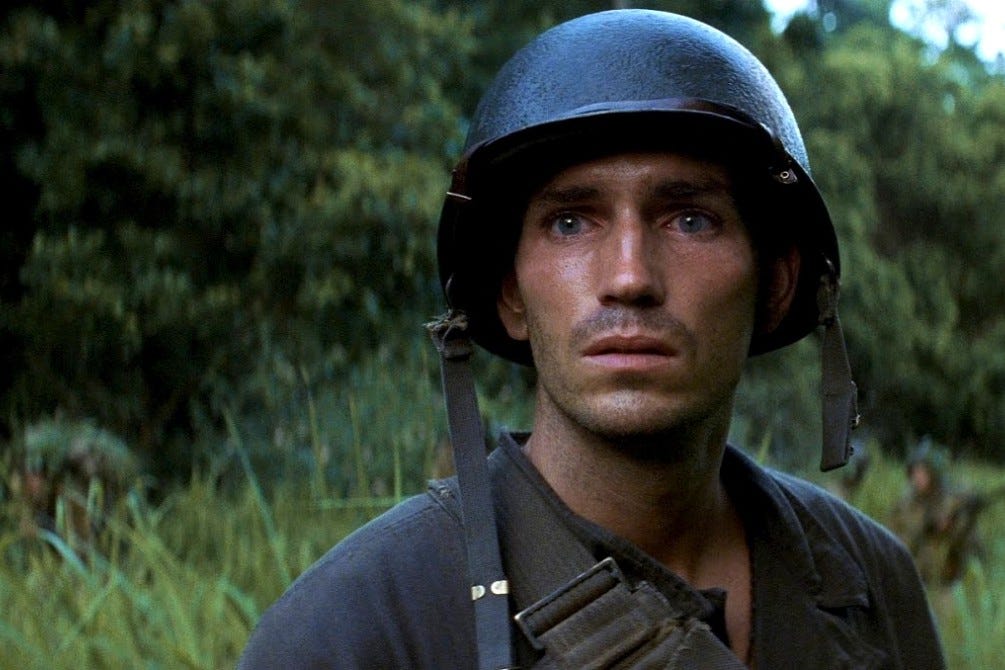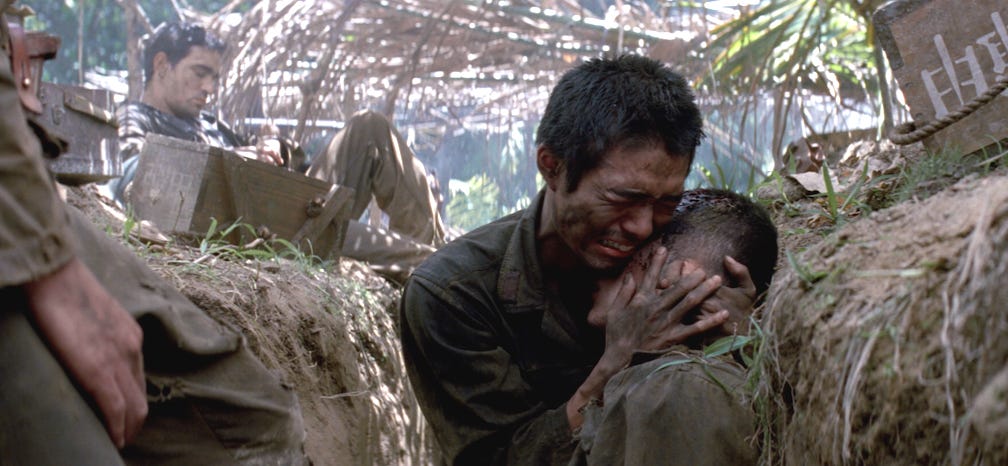1998 in Review: "The Thin Red Line"
First, an update. Thank you to all who were paid subscribers to this little project in 2023. It was fun to revisit these films, and to engage with your comments and responses. Unfortunately, I’ve decided not to move forward with it. 2024 is going to be a busy year for me. I’ll be promoting my baseball movie book and maybe putting together a proposal for a second book. I don’t have the bandwidth to continue writing for my merry band of dedicated readers. There will still be free pieces, so don’t unsubscribe quite yet. But there’s no need to continue with the payments, unless you just want to give me money out of the goodness of your hearts. Again, thank you for reading. Now, here’s The Thin Red Line.
“Why does nature vie with itself? The land contend with the sea? Is there an avenging power in nature? Not one power, but two?”
How does one write about The Thin Red Line? A critic’s biggest challenge in life is writing about pure cinema, which is what we call it when a movie communicates just in moving images, without character, dialogue, or possibly even narrative? How can you describe what can only be experienced? It’s like “dancing about architecture,” as someone once said about music criticism. The fact that the quote has never been attributed makes it seem even more true.
Terence Malick’s 1998 war masterpiece is a story told almost entirely through images. Loosely based on James Jones’s 1962 novel about the Battle of Guadalcanal, the film cannot be separated from the stories about its creation. Malick, who made two of the best films of the 1970s—Badlands and Days of Heaven—hadn’t been behind the camera in 20 years, and when he announced The Thin Red Line as his next project, every actor in Hollywood leapt to be part of it in any way they could. That’s how you have John Travolta and George Clooney in such small roles. But Malick famously rewrote the film during post-production, taking characters who were written (and shot) as leads and turning them into near-background actors. Famously, Adrien Brody’s Cpl. Fife was supposed to be the protagonist. As the film stands, he gets a mere few lines of dialogue.
In other words, The Thin Red Line is a work of true improvisation, which you can feel adding to its abstract, ethereal aesthetic as you’re watching it.. We often hear about films that are built in the editing room, but rarely is the lead character completely changed there. Instead of the terrified Fife, we open on the mysterious Pvt. Witt (Jim Caviezel), who has gone AWOL to live a simpler life with an indigenous tribe somewhere in the South Pacific. He’s another of Malick’s innocents, like Sissy Spacek in Badlands or Linda Manz in Days of Heaven, characters whose naivete is juxtaposed with the gritty realities of life. Caviezel is a remarkable screen presence in The Thin Red Line, and you can see why Mel Gibson chose him to play Jesus a few years later. He’s a liminal state in human form, his half-lidded eyes offering a glimpse of the eternal, making his willingness to face pain and torture—both in this film and that one—a choice rather than a burden.
This opening glimpse of paradise—complete with unforgettable shots of Witt swimming beneath the water’s surface with the island children—sets the stage for the next chapter: a long, chaotic recreation of the Battle of Guadalcanal, in which U.S. forces overcome the Japanese for the first time in the war. Malick deftly introduces his cast of soldiers, explaining the hierarchy in swift strokes. Nick Nolte is Lt. Col. Tall, an aging officer who was too young for WWII and is now commanding troops with little sense of the realities of battle. Elias Koteas is Capt. Starros, who is responsible for carrying out Tall’s orders. He’s too soft for war, and Tall is too hard for it. The initial surge is a disaster, but Tall orders Starros to press on, regardless of the loss of human life. Starros refuses. Their struggle over whether to send their troops on a suicide mission comprises the film’s riveting central conflict.
By “central,” I mean that it takes place roughly halfway through the film, but The Thin Red Line isn’t built around dramatic conflict, like they teach in screenwriting classes. It’s a film of forces and ideas that swell towards each other and then ebb away, aligning and conflicting in equal measure. Malick achieves a state of transcendence in the film’s battle scene, finding beauty and grace in the soldiers’ utter helplessness against the enemy force. Some get shot for merely lifting their heads above the tall grass. Another blows himself up when he accidentally pulls the pin out of a grenade attached to his belt; his act of heroism is throwing himself against a dirt wall so that he doesn’t take any of his comrades with him. The enemy exists only abstractly, as bursts of fire coming from a bunker. Victory is impossible. Survival seems unlikely. But Malick grounds this chaos in the sensate, ensuring the viewer feels every blade of grass, speck of dirt, and gust of wind. There are numerous shots of animals in the film—bats, alligators, snakes—most of them simply observing the horror that is playing out around them. This focus on nature immerses the viewer in the soldiers’ sensate experience, rather than living in their heads.
In this way, The Thin Red Line finds a path around Francois Truffaut’s famous assertion that it’s impossible to make an antiwar film because the act of narrativizing combat inevitably makes it feel like a little boy’s adventure. Technically, Malick’s soldiers are “men on a mission,” but this isn’t Saving Private Ryan or The Dirty Dozen. Their characters are not carefully devised to represent different demographics or imbued with conflicting philosophies on life. We barely know anything about them that their faces don’t reveal. For most of its runtime, it’s a film told in the present tense, with Malick conveying the sheer, horrifying chaos of a battle that seems unwinnable against an enemy force you can’t even see but who seems to know your every move.
It’s as poetic and searching an hour of war cinema as you will ever see, but something changes in the middle of The Thin Red Line. Right around the time that Tall takes over for Starros, things begin to bend towards the conventional. John Cusack shows up and leads a small crew of soldiers up to the bunker, where they battle and eventually defeat the soldiers through smart strategy and acts of bravery. It’s nearly identical to the opening sequence in Saving Private Ryan, which, after the chaos of the D-Day landing, devolves into a similarly narrow sequence. For a few minutes, we are rooting for these soldiers to take out their nameless, faceless enemies. When they do, we breathe a sigh of relief. The battle is over, and we have emerged victorious, but Malick doesn’t allow us to savor the win. He shows us the faces of the Japanese soldiers who survived. He hones in on their suffering, as they deal with the agony of defeat and loss. Their pain, beautifully captured by the Japanese actors, seems worse than death.
You could argue the film loses steam in the second half, but there’s a method to Malick’s madness. It’s as if those few minutes of straightforward war cinema come at a cost. We see the cost of victory. The soldiers seem as adrift as the film. Pvt. Bell (Ben Chaplin), who was driven only by his desire to see his wife again, gets a letter from her indicating she has fallen in love with someone else. Starros gets sent off to work behind a desk in Washington, far away from the testing grounds of war. The spark has gone out of these men, and to some degree, of the film. It’s a letdown after the thrilling artistry of the first hour, and maybe the film would have been more satisfying if it ended directly after the battle. But Malick wants to show the comedown, too, and he continues to poke and prod his subject long past the point when other films would stop.
While not particularly fair to either director, it’s difficult not to compare it to Saving Private Ryan, another WWII movie made in the ‘90s from a director who came of age in the ‘70s. Spielberg’s war epic also demonstrates the chaos of war, but it ends on a note of uplift, with its sole surviving soldier being reassured by his loving wife that he proved himself worthy of his comrades’ sacrifices. It’s a rousing film, but fifty years after the war, the public deserves a more thoughtful approach than mere reverence. That’s why Spielberg always felt out of step with the other maverick filmmakers of New Hollywood. He was drawn more to the gentle escapism of Hollywood’s Golden Age than the hard-earned authenticity of his time.
In comparison, The Thin Red Line feels more like a Vietnam movie than one about WWII. There’s the tropical setting, but also the madness and defeatism that threads through its story, the sense that war is not a thing that can be won, only survived, and even that survival is temporary. It’s there in its commitment to portraying the realities of battle without sentimentality or artifice. Despite being put together in an editing room, you can hear the boots on the ground, feel the dirt beneath your fingers, and smell the blood in the air. It’s the rare war film that actually has something to say about battle, rather than just tell us what we want to hear,



